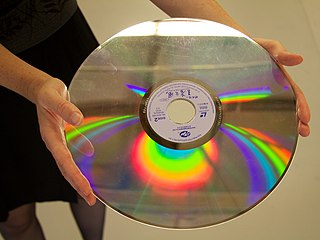
The compact disc (CD) is a digital optical disc data storage format that was co-developed by Philips and Sony to store and play digital audio recordings. It uses the Compact Disc Digital Audio format which typically provides 74 minutes of audio on a disc. In later years, the compact disc was adapted for non-audio computer data storage purposes as CD-ROM and its derivatives. First released in Japan in October 1982, the CD was the second optical disc technology to be invented, after the much larger LaserDisc (LD). By 2007, 200 billion CDs had been sold worldwide.

MP3 is a coding format for digital audio developed largely by the Fraunhofer Society in Germany under the lead of Karlheinz Brandenburg. It was designed to greatly reduce the amount of data required to represent audio, yet still sound like a faithful reproduction of the original uncompressed audio to most listeners; for example, compared to CD-quality digital audio, MP3 compression can commonly achieve a 75–95% reduction in size, depending on the bit rate. In popular usage, MP3 often refers to files of sound or music recordings stored in the MP3 file format (.mp3) on consumer electronic devices.

MPEG-2 is a standard for "the generic coding of moving pictures and associated audio information". It describes a combination of lossy video compression and lossy audio data compression methods, which permit storage and transmission of movies using currently available storage media and transmission bandwidth. While MPEG-2 is not as efficient as newer standards such as H.264/AVC and H.265/HEVC, backwards compatibility with existing hardware and software means it is still widely used, for example in over-the-air digital television broadcasting and in the DVD-Video standard.

A phonograph, later called a gramophone, and since the 1940s a record player, or more recently a turntable, is a device for the mechanical and analogue reproduction of recorded sound. The sound vibration waveforms are recorded as corresponding physical deviations of a helical or spiral groove engraved, etched, incised, or impressed into the surface of a rotating cylinder or disc, called a "record". To recreate the sound, the surface is similarly rotated while a playback stylus traces the groove and is therefore vibrated by it, faintly reproducing the recorded sound. In early acoustic phonographs, the stylus vibrated a diaphragm that produced sound waves coupled to the open air through a flaring horn, or directly to the listener's ears through stethoscope-type earphones.

Vorbis is a free and open-source software project headed by the Xiph.Org Foundation. The project produces an audio coding format and software reference encoder/decoder (codec) for lossy audio compression, libvorbis. Vorbis is most commonly used in conjunction with the Ogg container format and it is therefore often referred to as Ogg Vorbis.

Walkman is a brand of portable audio players manufactured and marketed by Japanese company Sony since 1979. The original Walkman started out as a portable cassette player and the brand was later extended to serve most of Sony's portable audio devices; since 2011 it consists exclusively of digital flash memory players. The current flagship product as of 2022 is the WM1ZM2 player.

Compact Disc Digital Audio, also known as Digital Audio Compact Disc or simply as Audio CD, is the standard format for audio compact discs. The standard is defined in the Red Book technical specifications, which is why the format is also dubbed "Redbook audio" in some contexts. CDDA utilizes pulse-code modulation (PCM) and uses a 44,100 Hz sampling frequency and 16-bit resolution, and was originally specified to store up to 74 minutes of stereo audio per disc.

The iPod is a discontinued series of portable media players and multi-purpose mobile devices that were designed and marketed by Apple Inc. from 2001 to 2022. The first version was released on November 10, 2001, about 8+1⁄2 months after the Macintosh version of iTunes was released. Apple sold an estimated 450 million iPod products as of 2022. Apple discontinued the iPod product line on May 10, 2022. At over 20 years, the iPod brand is the longest-running to be discontinued by Apple.

The Floyd Rose Locking Tremolo, or simply Floyd Rose, is a type of locking vibrato arm for a guitar. Floyd D. Rose invented the locking vibrato in 1976, the first of its kind, and it is now manufactured by a company of the same name. The Floyd Rose gained popularity in the 1980s through guitarists like Eddie Van Halen, Neal Schon, Brad Gillis, Joe Satriani, Steve Vai, and Alex Lifeson, who used its ability to stay in tune even with extreme changes in pitch. Its tuning stability comes through the double-locking design that has been widely regarded as revolutionary; the design has been listed on Guitar World's "10 Most Earth Shaking Guitar Innovations" and Guitar Player's "101 Greatest Moments in Guitar History 1979–1983."

The LaserDisc (LD) is a home video format and the first commercial optical disc storage medium, initially licensed, sold and marketed as MCA DiscoVision in the United States in 1978. Its diameter typically spans 30 cm (12 in). Unlike most optical-disc standards, LaserDisc is not fully digital, and instead requires the use of analog video signals.

A laser turntable is a phonograph that plays standard LP records using laser beams as the pickup instead of using a stylus as in conventional turntables. Although these turntables use laser pickups, the same as Compact Disc players, the signal remains in the analog realm and is never digitized.

In digital recording, an audio or video signal is converted into a stream of discrete numbers representing the changes over time in air pressure for audio, or chroma and luminance values for video. This number stream is saved to a storage device. To play back a digital recording, the numbers are retrieved and converted back into their original analog audio or video forms so that they can be heard or seen.
A podcast is a program made available in digital format for download over the Internet. Typically, a podcast is an episodic series of digital audio files that users can download to a personal device to listen to at a time of their choosing. Podcasts are primarily an audio medium, but some distribute in video, either as their primary content or as a supplement to audio; popularised in recent years by video platform YouTube.

ZEN is a series of portable media players designed and manufactured by Creative Technology Limited from 2004 to 2011. The players evolved from the NOMAD brand through the NOMAD Jukebox series of music players, with the first separate "ZEN" branded models released in 2004. The last Creative Zen player, X-Fi3, was released at the end of 2011.

A portable media player (PMP) or digital audio player (DAP) is a portable consumer electronics device capable of storing and playing digital media such as audio, images, and video files. The data is typically stored on a compact disc (CD), Digital Versatile Disc (DVD), Blu-ray Disc (BD), flash memory, microdrive, SD cards or hard disk drive; most earlier PMPs used physical media, but modern players mostly use flash memory. In contrast, analogue portable audio players play music from non-digital media that use analogue media, such as cassette tapes or vinyl records.

Sound recording and reproduction is the electrical, mechanical, electronic, or digital inscription and re-creation of sound waves, such as spoken voice, singing, instrumental music, or sound effects. The two main classes of sound recording technology are analog recording and digital recording.
Kane Kramer is a British inventor and businessman. He is credited with the initial invention of the digital audio player, in 1979.
The history of optical recording can be divided into a few number of distinct major contributions. The pioneers of optical recording worked mostly independently, and their solutions to the many technical challenges have very distinctive features, such as
Marsh Marshall is an American economist, venture capital and hedge fund manager, and television producer. He is the author of "Organizations and Growth in Rural China", academic and newspaper articles on China's economy and on venture capital investing. He is currently Chief Operating Officer at the quantitative hedge fund, Periwinkle Trading LLC, and is writing a book on investment, economic growth and corporate governance.














